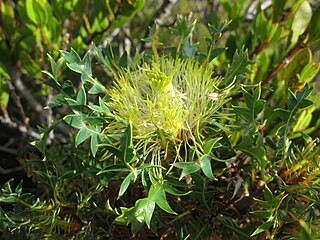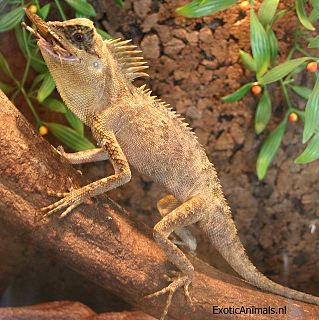
The Chilean angelshark is an angelshark of the family Squatinidae found in the subtropical waters of Chile, that grows up to 1.03 metres in length. The holotype is lost. Reproduction is ovoviviparous.

Banksia armata, commonly known as prickly dryandra, is a species of often sprawling shrub that is endemic to Western Australia. It has deeply serrated leaves with sharply pointed lobes and spikes of about 45 to 70 yellow flowers.
Banksia prionophylla is a shrub endemic to Western Australia. Known only from a single population of around 70 plants in a remote part of Western Australia, it is considered rare but not endangered. It was first discovered in 2001, and published under the genus Dryandra in 2005, before being transferred into Banksia in 2007.

Banksia armata var. armata is a variety of shrub that is endemic to Western Australia. It differs from the other variety in having a lignotuber, narrower leaves with more sides lobes and shorter flowers. It is also usually a shorter plant.

Banksia armata var. ignicida is a variety of shrub that is endemic to Western Australia. It differs from the autonym in not having a lignotuber. It is also usually a taller plant with leaves that are longer with fewer side lobes, and longer flowers.
Robert Brown's taxonomic arrangement of Dryandra was the first arrangement of what is now Banksia ser. Dryandra. His initial arrangement was published in 1810, and a further arrangement, including an infrageneric classification, followed in 1830. Aspects of Brown's arrangements can be recognised in the later arrangements of George Bentham and Alex George.

Dryandra subg. Dryandra is an obsolete clade of plant. It was a series within the former genus Dryandra. The name was first published at sectional rank as Dryandra verae in 1830, before being renamed Eudryandra in 1847, the replaced by the autonym at subgenus rank in 1996. It was ultimately discarded in 2007 when Austin Mast and Kevin Thiele sunk Dryandra into Banksia.

Dryandra ser. Armatae is an obsolete series within the former genus Dryandra. It was first published by George Bentham in 1870, and was given a new circumscription by Alex George in 1996, but was ultimately discarded in 2007 when Austin Mast and Kevin Thiele sunk Dryandra into Banksia.

Neritopsidae is a family of small sea snails and freshwater snails in the clade Cycloneritimorpha.

Carebara diversa, is a species of marauder ant widely distributed throughout Asia.
Taringa armata is a species of sea slug, a dorid nudibranch, shell-less marine opisthobranch gastropod mollusks in the family Discodorididae.
Nophodoris is a genus of sea slugs, specifically dorid nudibranchs. They are marine gastropod molluscs in the family Discodorididae.

Bathyliotina armata, is a species of sea snail, a marine gastropod mollusk in the family Liotiidae.

Carebara is a genus of ants in the subfamily Myrmicinae. It is one of the largest myrmicine genera with more than 200 species distributed worldwide in the tropics and the Afrotropical region. Many of them are very tiny cryptic soil and leaf litter inhabitants. They nest in rotten wood to which the bark is still adherent in the Afrotropical region, or may be lestobiotic nesting near other ant species. Some species are known to exist parasitically within termite nests. Little is known about the biology of the species. However, they are notable for the vast difference in size between queens and workers.
Carebara bruni is a species of ant in the subfamily Formicinae. It is found in Sri Lanka and China.
Carebara nana is a species of ant in the subfamily Formicinae. It is found in Sri Lanka.
Carebara pygmaea is a species of ant in the subfamily Formicinae. It is found in Sri Lanka, Borneo, Indonesia, Philippines.
Carebara sinhala is a species of ant in the subfamily Formicinae. It is found in Sri Lanka.

Acanthosaura armata is a species of agamid lizard commonly known as the armored pricklenape or peninsular horned tree lizard. A. armata can be found in China (Hainan), Myanmar, Thailand, Peninsular Malaysia, Singapore, and Indonesia (Sumatra).










